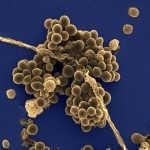Lien vers Pubmed [PMID] – 10418150
FEMS Microbiol. Lett. 1999 Jul;176(1):229-33
We characterized Yersinia enterocolitica and Yersinia pseudotuberculosis insertion sequences related to insertion sequence 1541, recently identified in Yersinia pestis. For each of the two species, two insertion sequence copies were cloned and sequenced. Genetic elements from Y. pseudotuberculosis were almost identical to insertion sequence 1541, whereas these from Y. enterocolitica were less related. Phylogenetic analysis of the putative transposases encoded by insertion sequences from the three pathogenic members of the genus Yersinia showed that they clustered with those encoded by Escherichia coli and Salmonella enterica elements belonging to the insertion sequence 200/insertion sequence 605 group. Insertion sequences originating from Y. pestis and Y. pseudotuberculosis constitute a monophyletic lineage distinct from that of Y. enterocolitica.

